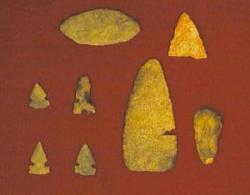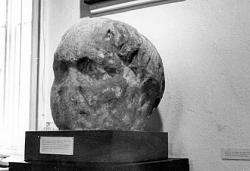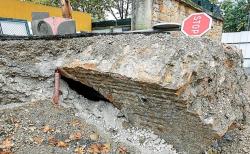INSTITUT SUPERIEUR D'ANTHROPOLOGIE
INSTITUTE OF ANTHROPOLOGY
ONLINE COURSES / COURS A DISTANCE
FALL TERM : OCTOBER 2013
REGISTER NOW
ROYAUME UNI –  Southam - Archaeologists working at the town's Little Park have uncovered the remains of a building, thought to be a medieval tithe barn. The archaeology team have discovered the foundations of three sides of a substantial stone building with walls about a metre wide constructed of local limestone blocks. The exposed foundations are 18 metres long and over 10 metres wide but it is thought that the Southam barn would have originally been about 40 metres long. A cobbled surface survives at the entrance. Tithe barns were used to store the tithe - or a tenth of a farmer's produce - which was to be given to the Church. As this tax was paid in kind, the barn would be filled with whatever crop the farmers had been growing, often wheat or barley. The walls would have supported a substantial oak frame and a tiled roof. Internal posts would have formed bays within the barn and a porch at the entrance would have held large wooden doors through which the crops would have been delivered by cart. Southam manor was endowed to Coventry Priory in 1043. It is therefore likely that a large proportion of the tithes collected here would have been transported to Coventry for the use of the Priory itself. The Priory retained control of the manor through the medieval period until the Reformation, by which time the manor had become a very valuable one - the priory is for example recorded to have received over £55 in revenue in 1535. A wide deep ditch was identified running almost parallel, some 15m north of the tithe barn. It contained Roman-British pottery shards, which indicate that there was settlement here between 700 and 1,000 years earlier than the construction of the tithe barn. It was overlain by another stone wall of similar character to that of the tithe barn, along the same alignment as the ditch, which suggests that the ditch was still visible in the landscape at this time.
Southam - Archaeologists working at the town's Little Park have uncovered the remains of a building, thought to be a medieval tithe barn. The archaeology team have discovered the foundations of three sides of a substantial stone building with walls about a metre wide constructed of local limestone blocks. The exposed foundations are 18 metres long and over 10 metres wide but it is thought that the Southam barn would have originally been about 40 metres long. A cobbled surface survives at the entrance. Tithe barns were used to store the tithe - or a tenth of a farmer's produce - which was to be given to the Church. As this tax was paid in kind, the barn would be filled with whatever crop the farmers had been growing, often wheat or barley. The walls would have supported a substantial oak frame and a tiled roof. Internal posts would have formed bays within the barn and a porch at the entrance would have held large wooden doors through which the crops would have been delivered by cart. Southam manor was endowed to Coventry Priory in 1043. It is therefore likely that a large proportion of the tithes collected here would have been transported to Coventry for the use of the Priory itself. The Priory retained control of the manor through the medieval period until the Reformation, by which time the manor had become a very valuable one - the priory is for example recorded to have received over £55 in revenue in 1535. A wide deep ditch was identified running almost parallel, some 15m north of the tithe barn. It contained Roman-British pottery shards, which indicate that there was settlement here between 700 and 1,000 years earlier than the construction of the tithe barn. It was overlain by another stone wall of similar character to that of the tithe barn, along the same alignment as the ditch, which suggests that the ditch was still visible in the landscape at this time.
http://leamingtonobserver.co.uk/2013/10/01/news-Medieval-barn-uncovered-in-Southam-80032.html
USA –  Le Sueur County - There have been people living in what is now Le Sueur County for more than 13,000 years, and now there is a project underway to find out more about the area’s past. Minnesota State University, Mankato Professor Dr. Ron Shirmer and his graduate students are undertaking a full-scale archaeological survey of the county. The survey is designed to uncover more information about the Native American culture in the county, as there is not much known now. Schirmer said that the history of counties in Minnesota is uneven, as places like Goodhue County have around 300 archaeological sites, where as Le Sueur County has fewer than 100. Even though there is a disparity, it is not because little happened in Le Sueur County. The point of the survey is also to preserve artifacts and archaeological sites. Some of the artifacts and sites that have been found in the county have not been revisited for more than 100 years. The items could be lost or destroyed, forever losing that part of history. The survey can also bring attention to certain historical sites that have not yet been discovered, and help keep the sites from being unknowingly destroyed.
Le Sueur County - There have been people living in what is now Le Sueur County for more than 13,000 years, and now there is a project underway to find out more about the area’s past. Minnesota State University, Mankato Professor Dr. Ron Shirmer and his graduate students are undertaking a full-scale archaeological survey of the county. The survey is designed to uncover more information about the Native American culture in the county, as there is not much known now. Schirmer said that the history of counties in Minnesota is uneven, as places like Goodhue County have around 300 archaeological sites, where as Le Sueur County has fewer than 100. Even though there is a disparity, it is not because little happened in Le Sueur County. The point of the survey is also to preserve artifacts and archaeological sites. Some of the artifacts and sites that have been found in the county have not been revisited for more than 100 years. The items could be lost or destroyed, forever losing that part of history. The survey can also bring attention to certain historical sites that have not yet been discovered, and help keep the sites from being unknowingly destroyed.
http://www.southernminn.com/le_center_leader/news/article_59091232-9639-57dd-a528-dfb16ac9b272.html
ROYAUME UNI –  Bosham - A 26-stone head found in a flower bed in a Hampshire vicarage garden could represent Nero, the rarely-glimpsed Emperor whose first century rule over the Roman Empire began when he was a 14-year-old. Known as the Bosham Head, the spectacular cranium imposes itself within the Collections Discovery Centre at Fishbourne. Archaeologists have been using 3D scanning in a bid to determine whether it was carved seperately from its body. “The Jupiter Stone found beneath the post office on West Street depicts the iconic image of the three graces, although only two women are shown,” says Anooshka Rawden, the Collections Officer at Chichester’s Novium museum.
Bosham - A 26-stone head found in a flower bed in a Hampshire vicarage garden could represent Nero, the rarely-glimpsed Emperor whose first century rule over the Roman Empire began when he was a 14-year-old. Known as the Bosham Head, the spectacular cranium imposes itself within the Collections Discovery Centre at Fishbourne. Archaeologists have been using 3D scanning in a bid to determine whether it was carved seperately from its body. “The Jupiter Stone found beneath the post office on West Street depicts the iconic image of the three graces, although only two women are shown,” says Anooshka Rawden, the Collections Officer at Chichester’s Novium museum.
http://www.culture24.org.uk/history-and-heritage/time/roman/art452642
FRANCE –  Lyon - Sous les pieds de la future résidence universitaire Magnin, il y a des trésors encore enfouis qui ne demandent qu'à être déterrés. Le bâtiment sera érigé à la place d'une ancienne maison de retraite, rue des Farges sur les hauteurs de Saint-Just, à proximité de l'Odéon et du théâtre antique de Fourvière. Un secteur dont le potentiel archéologique est très important. Au préalable, des fouilles seront menées afin de dégager des vestiges gallo-romains ou médiévaux. Le chantier devrait débuter au mois de janvier. «Nous devrions faire de belles découvertes», prédit Anne Pariente, directrice du service archéologique de Lyon. En 1968, lors de la construction de la maison de retraite, une muraille de 4 m de haut et 1, 80 m de large a été mise à jour. «Cette muraille est encore présente, explique Anne Pariente. Il s'agira de déterminer s'il s'agit d'un mur de soutènement ou d'un rempart car les archives et les vestiges montrent que Lyon était protégé par des remparts.» Une enceinte construite par Charles V (1362) pour se défendre des attaques anglaises. «On sait qu'il y a eu de part et d'autre de ce site des habitats antiques avec des entrepôts et des boutiques ouvrant sur la rue, poursuit l'archéologue. Mais ce qui nous étonne, c'est la présence d'un espace funéraire au pied de cette muraille. Il nous faut désormais découvrir l'étendue de cet espace et le nombre de tombes qu'il recensait.» Reste à espérer de belles surprises, comme lors des fouilles sous le Pathé de Vaise, où un ensemble de chambres funéraires à étage abritant des animaux et probablement leurs propriétaires avait été mis à jour. Des formes de sépultures totalement inédites en France.
Lyon - Sous les pieds de la future résidence universitaire Magnin, il y a des trésors encore enfouis qui ne demandent qu'à être déterrés. Le bâtiment sera érigé à la place d'une ancienne maison de retraite, rue des Farges sur les hauteurs de Saint-Just, à proximité de l'Odéon et du théâtre antique de Fourvière. Un secteur dont le potentiel archéologique est très important. Au préalable, des fouilles seront menées afin de dégager des vestiges gallo-romains ou médiévaux. Le chantier devrait débuter au mois de janvier. «Nous devrions faire de belles découvertes», prédit Anne Pariente, directrice du service archéologique de Lyon. En 1968, lors de la construction de la maison de retraite, une muraille de 4 m de haut et 1, 80 m de large a été mise à jour. «Cette muraille est encore présente, explique Anne Pariente. Il s'agira de déterminer s'il s'agit d'un mur de soutènement ou d'un rempart car les archives et les vestiges montrent que Lyon était protégé par des remparts.» Une enceinte construite par Charles V (1362) pour se défendre des attaques anglaises. «On sait qu'il y a eu de part et d'autre de ce site des habitats antiques avec des entrepôts et des boutiques ouvrant sur la rue, poursuit l'archéologue. Mais ce qui nous étonne, c'est la présence d'un espace funéraire au pied de cette muraille. Il nous faut désormais découvrir l'étendue de cet espace et le nombre de tombes qu'il recensait.» Reste à espérer de belles surprises, comme lors des fouilles sous le Pathé de Vaise, où un ensemble de chambres funéraires à étage abritant des animaux et probablement leurs propriétaires avait été mis à jour. Des formes de sépultures totalement inédites en France.
http://www.20minutes.fr/lyon/1229515-tresors-deterrer-st-just
FRANCE –  Nice - Un bateau scientifique a exploré les fonds marins entre Nice et Villefranche-sur-mer. Entre pilleurs d’épaves, ancres baladeuses et érosion naturelle, la préservation de ces vestiges engloutis est fragile. A quelques brasses de la Promenade-des-Anglais, L’André-Malraux a croisé quinze jours. Ce bateau d’exploration scientifique flambant neuf créé pour le Drassm, le département des recherches archéologiques subaquatiques et sous-marines, a sondé les fonds à la recherche de vestiges, dans le cadre d’un partenariat avec la ville de Nice. "Nice était sur une autoroute maritime, il y a peut-être là des chaînons manquants sur l’interprétation des civilisations" souligne Frédéric Leroy, adjoint au directeur pour la recherche archéologique programmée et préventive. Plusieurs épaves, datant des IIème et IVème siècle avant Jésus-Christ, ont été observées. Quelque 42 gisements archéologiques potentiels ont été répertoriés, sur 17 secteurs où des concentrations importantes de céramiques ont été identifiées, entre 15 et 90 mètres de fond. Mais à bord, les archéologues préfèrent rester discrets sur leur localisation pour ne pas attirer les pilleurs. Plus à l’Est, face à Villefranche-sur-Mer, l’André-Malraux s’est attardé à la verticale du joyau de la rade. La Sainte Dorothéa, un navire marchand danois qui repose depuis son naufrage, en 1693, est une "épave exceptionnelle" souligne l’archéologue. Certains de ses canons sont encore en place et sa coque de bois, protégée par la vase, reste dans un excellent état de conservation. A 72 mètres de profondeur, ce trésor archéologique repose suffisamment profondément pour ne pas craindre les pilleurs. Mais il a échappé de peu à la destruction : sur les images que vient de filmer la caméra du ROV, le minirobot sous-marin équipant l’André-Malraux, on voit une énorme trace à quelques mètres de l’épave. "C’est l’ancre d’un paquebot de croisière qui a raclé le fond" interprète un archéologue. Dans la rade, La Lomellina, coulée par une tempête le 15 septembre 1516, est aussi l’objet de toutes les attentions des scientifiques. "Nous l’avons relocalisée plus précisément et fait un constat de son état général. Nous envisageons de la recouvrir de vase l’année prochaine pour éviter l’érosion".
Nice - Un bateau scientifique a exploré les fonds marins entre Nice et Villefranche-sur-mer. Entre pilleurs d’épaves, ancres baladeuses et érosion naturelle, la préservation de ces vestiges engloutis est fragile. A quelques brasses de la Promenade-des-Anglais, L’André-Malraux a croisé quinze jours. Ce bateau d’exploration scientifique flambant neuf créé pour le Drassm, le département des recherches archéologiques subaquatiques et sous-marines, a sondé les fonds à la recherche de vestiges, dans le cadre d’un partenariat avec la ville de Nice. "Nice était sur une autoroute maritime, il y a peut-être là des chaînons manquants sur l’interprétation des civilisations" souligne Frédéric Leroy, adjoint au directeur pour la recherche archéologique programmée et préventive. Plusieurs épaves, datant des IIème et IVème siècle avant Jésus-Christ, ont été observées. Quelque 42 gisements archéologiques potentiels ont été répertoriés, sur 17 secteurs où des concentrations importantes de céramiques ont été identifiées, entre 15 et 90 mètres de fond. Mais à bord, les archéologues préfèrent rester discrets sur leur localisation pour ne pas attirer les pilleurs. Plus à l’Est, face à Villefranche-sur-Mer, l’André-Malraux s’est attardé à la verticale du joyau de la rade. La Sainte Dorothéa, un navire marchand danois qui repose depuis son naufrage, en 1693, est une "épave exceptionnelle" souligne l’archéologue. Certains de ses canons sont encore en place et sa coque de bois, protégée par la vase, reste dans un excellent état de conservation. A 72 mètres de profondeur, ce trésor archéologique repose suffisamment profondément pour ne pas craindre les pilleurs. Mais il a échappé de peu à la destruction : sur les images que vient de filmer la caméra du ROV, le minirobot sous-marin équipant l’André-Malraux, on voit une énorme trace à quelques mètres de l’épave. "C’est l’ancre d’un paquebot de croisière qui a raclé le fond" interprète un archéologue. Dans la rade, La Lomellina, coulée par une tempête le 15 septembre 1516, est aussi l’objet de toutes les attentions des scientifiques. "Nous l’avons relocalisée plus précisément et fait un constat de son état général. Nous envisageons de la recouvrir de vase l’année prochaine pour éviter l’érosion".
http://www.metronews.fr/nice-cannes/un-bateau-explore-des-vestiges-sous-marins-en-danger-a-nice/mmiC!vSq2xHT6yQQM/